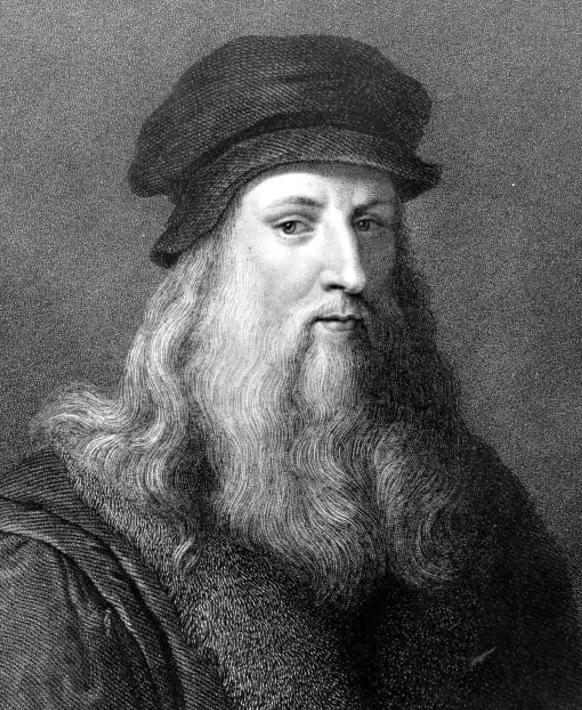
Leonardo da Vinci Biography begins with the story of a Renaissance genius who transformed the worlds of art and science.
If you’re seeking to understand the extraordinary life of Leonardo da Vinci, this post will enlighten you with insights into his life, works, and enduring influence.
Exploring his multifaceted talents will provide a clearer picture of why his legacy continues to captivate minds.
Leonardo da Vinci was a master artist and visionary thinker whose innovations were centuries ahead of their time.
Known for masterpieces such as “Mona Lisa” and “The Last Supper,” he was also an accomplished scientist, inventor, and engineer. His notebooks reveal a mind teeming with ideas, including concepts for the helicopter and tank.
Leonardo da Vinci’s influence spanned numerous fields, with his curiosity and creativity shaping his work in anatomy, engineering, and many other areas. His impact on the art world and beyond makes him a pivotal figure in history.
The Artistic and Scientific Pursuits of a Renaissance Polymath
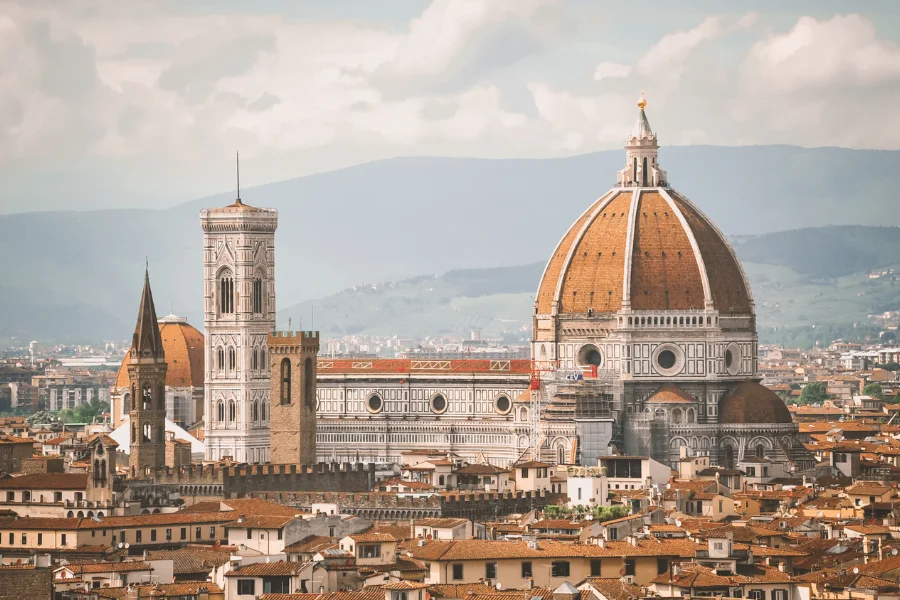
Leonardo da Vinci’s enduring fame can be attributed to his insatiable thirst for knowledge, which shaped his thinking and behavior. As an artist, he valued sight above all other senses, considering it the most reliable source of experiential learning.
Leonardo’s commitment to “knowing how to see” was a central theme of his work. He applied his artistic talents to various fields, including painting, architecture, and engineering.
The Formative Years (Florence)
What formative experiences led him to become the Renaissance master he is known for today?
Leonardo da Vinci’s early life was marked by his modest family and illegitimacy, which left him without the privileges of noble birth. Nonetheless, he received an education in reading, writing, and arithmetic, as well as a basic knowledge of Latin, which laid the foundation for his later studies of science and philosophy.
At the age of 14, Leonardo began his apprenticeship with Andrea del Verrocchio, a prominent artist and craftsman in Florence. There, he learned the techniques of painting, sculpture, and metalworking, as well as the principles of perspective and anatomy. He soon surpassed his master in talent and innovation and began to attract his patrons and commissions.
The influence of Florentine painting, particularly that of artists such as Andrea del Castagno, Antonio Pollaiuolo, and Sandro Botticelli, also played a crucial role in Leonardo’s development. He studied their works closely and adopted their styles and techniques, which he later refined and expanded upon in his paintings.
Leonardo’s early artistic works, such as The Baptism of Christ and The Annunciation, reveal his mastery of perspective, composition, realism, and innovative use of light and shadow. They also demonstrate his fascination with the natural world and his early interest in scientific observation.
Leonardo’s Move to Milan (1482-1499)
Leonardo da Vinci’s move to Milan marked a turning point in his artistic and professional career. The Duke of Milan, Ludovico Sforza, invited him to work as a court artist and engineer. Leonardo developed his skills in painting, sculpture, and engineering during this time.
Under Ludovico’s patronage, Leonardo produced several masterpieces, including The Last Supper, a stunning fresco depicting Jesus and his disciples during the Last Supper. The painting is famous for its innovative use of perspective and Leonardo’s ability to capture the emotions of his subjects.
In addition to his artistic pursuits, Leonardo worked on several engineering projects for Ludovico, including the design of war machines and fortifications. He also studied anatomy and optics, producing numerous sketches and notes in his famous notebooks.
Overall, Leonardo’s time in Milan was pivotal in his career, as it allowed him to explore new techniques and interests that shaped his work for years. His works from this period, including The Last Supper and Horse and Rider, continue to captivate audiences with their beauty and technical skill.
The Florentine Years (1500-1508)
Leonardo da Vinci’s return to Florence and his work for the Medici family marked a turning point in his artistic and intellectual pursuits.
Upon his return to Florence, Leonardo found himself in a vibrant cultural scene, with the Medici family at the forefront of the city’s artistic and intellectual life. He quickly gained the patronage of Lorenzo de’ Medici, who recognized his talent and commissioned him to create works..
However, Leonardo’s interests extended far beyond the realm of art. He began studying science, engineering, and anatomy, filling his notebooks with observations and sketches of everything from bird movements to the human body’s structure.
His studies of flight led him to design flying machines and study the principles of aerodynamics, while his investigations of optics and light informed his painting techniques.
One of Leonardo’s most iconic works from this period is The Vitruvian Man, a drawing of a figure in two superimposed positions, with its arms and legs extended and inscribed within a circle and a square. The drawing represents the ideal human proportions, as described by the Roman architect Vitruvius, reflecting Leonardo’s interest in mathematics and geometry.
Leonardo’s work for the Medici family also included engineering projects, such as designing a canal system and creating theatrical productions. He ventured into military engineering, developing weapons and fortifications for the Medici family’s military campaigns.
The Second Milan Years (1508-1513)
Charles d’Amboise, the French governor in Milan, requested that Leonardo travel to Milan in May 1506, which the Signoria in Florence granted. Consequently, Leonardo left the Battle of Anghiari unfinished due to unsuccessful technical experiments with paints.
In the winter of 1507-08, Leonardo went to Florence to assist the sculptor Giovanni Francesco Rustici in executing his bronze statues for the Florence Baptistery, and then settled in Milan.
In Milan, Leonardo’s duties were primarily advisory in architectural matters, with plans for a palace villa for Charles and sketches for an oratory for the church of Santa Maria alla Fontana, which Charles founded. Additionally, he investigated the Adda River, which would connect Milan with Lake Como by water.
During this period, Leonardo painted very little. Still, he continued to teach his students, including Cesare da Sesto, Giampetrino, Bernardino Luini, and Francesco Melzi, his most faithful friend and companion, until the artist’s death.
He also received an important commission from Gian Giacomo Trivulzio to sculpt his tomb in the mortuary chapel, which was donated to the Church of San Nazaro Maggiore.
Leonardo’s scientific pursuits flourished during this period, particularly in the field of anatomy. He collaborated with Marcantonio della Torre to plan a comprehensive work that included exact reproductions of the human body and its organs, comparative anatomy, and physiology.
He also delved into mathematics, optics, mechanics, geology, and botany, driven by the conviction that force and motion produce all forms in nature by harmonious laws.
The Final Years (1513-1519)
Leonardo da Vinci’s artistic career was marked by his travels and patronage of several notable figures. After leaving Milan, he moved to Rome and began working for Pope Leo X.
He completed several works there, including “St. John the Baptist” and “The Battle of Anghiari,” which showcased his mastery of painting and composition.
Later, Leonardo returned to France and served under King Francis I. During this time, he created some of his most famous works, such as the Mona Lisa.
However, his final projects, including studies of human anatomy and plans for inventions such as flying machines and weapons, were left unfinished after he died in 1519.
Artistic Achievements
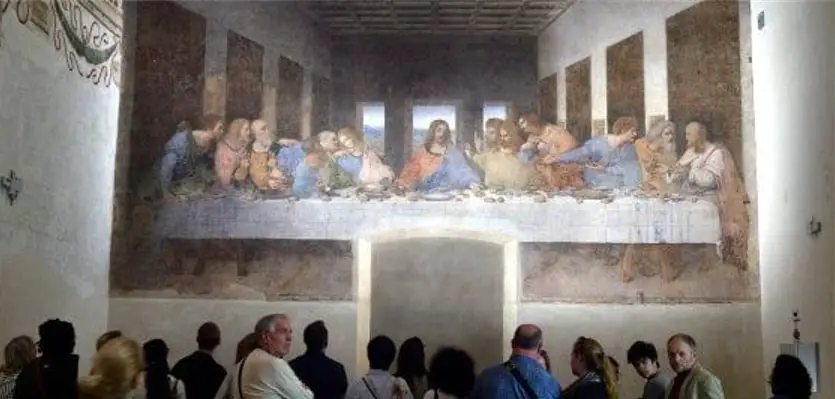
Leonardo da Vinci left a profound mark on art with his masterpieces and innovations. His paintings, drawings, and notebooks offer unique insights into his genius. Each work reflects his profound understanding and exploration of human anatomy and the beauty of nature.
The Last Supper
Leonardo da Vinci’s “The Last Supper” is a monumental work in Milan’s Convent of Santa Maria delle Grazie. Completed around 1498, it depicts the moment Jesus announces that one of the apostles will betray him.
This fresco embodies a perfect blend of composition, emotion, and detail. The perspective guides the viewer’s eye to Christ at the center, creating a dynamic scene.
The expressions and gestures of the apostles add depth to this celebrated piece of Leonardo da Vinci’s paintings.
Mona Lisa
The “Mona Lisa” is Leonardo da Vinci’s most famous painting. This portrait of an enigmatic woman is housed in the Louvre Museum in Paris. Completed in the early 16th century, it is a testament to da Vinci’s mastery of sfumato—a technique that creates a soft transition between colors and tones.
The subject’s mysterious smile and the serene landscape background have fascinated art lovers and scholars for generations. The “Mona Lisa” continues to captivate audiences worldwide and remains a defining example of Leonardo da Vinci’s artworks.
Notebooks and Drawings
Leonardo’s notebooks are filled with sketches and writings that reveal his diverse interests and talents. They include anatomy, engineering, and flight studies, highlighting the breadth of his curiosity.
His famous drawing, the “Vitruvian Man,” exemplifies the harmony of human proportion. These notebooks illustrate his artistic process and scientific inquiries.
As a visionary thinker, he often merged art and science, showcasing the innovative spirit that Leonardo da Vinci biography frequently highlights.
Lesser-Known Works
Beyond the renowned masterpieces, Leonardo produced several lesser-known works. Paintings like “Salvator Mundi” and the “Benois Madonna” exemplify his skill and innovation in religious art.
His smaller sketches and unfinished projects also glimpse his artistic journey. Although not as well-known, these works offer valuable insights into Leonardo da Vinci’s techniques and creative process. They enrich our understanding of his accomplishments in the art world and provide a broader perspective on his artistic genius.
Scientific Inquiries
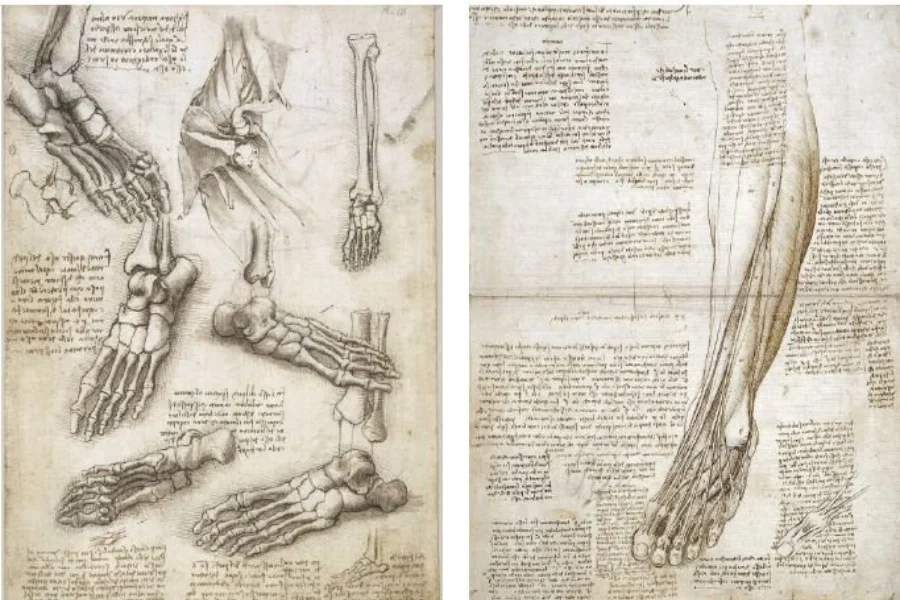
Leonardo da Vinci was a true polymath, blending art with science. His studies in anatomy and engineering demonstrate his genius; these areas have highlighted his innovative mind and meticulous observational skills.
Anatomy Studies
Leonardo’s fascination with the human body led him to dissect numerous corpses to understand their structure. He created detailed drawings and notes, which are still admired for accuracy.
His studies went beyond muscles and bones. He investigated the function of organs and the cardiovascular system. This work was revolutionary for his time and offered insights that would not be surpassed for centuries.
His anatomical drawings remain influential and highly regarded in medical and art communities. These detailed sketches reflect his unique ability to combine precise scientific inquiry with artistic skill.
Leonardo’s work in anatomy showcased an intricate understanding of the human form that continues to inspire modern scientists and artists.
Inventions and Engineering
Da Vinci’s engineering ambitions reflected his innovative spirit. Among his numerous designs were flying machines, such as the ornithopter, and advanced weaponry, like the giant crossbow.
Although many of these inventions were never built during his lifetime, they demonstrate his forward-thinking approach to problem-solving. His design notebooks reveal concepts that foreshadow modern technology.
Leonardo’s engineering prowess is evident in projects such as the designs for bridges and hydraulic pumps. Many of his ideas were ahead of their time, blending imagination with technical drawing skills.
His interest in hydrodynamics reflected his keen observation of natural phenomena, proving his status as a visionary thinker. His significant contributions to engineering and invention remain a testament to his broader influence beyond his famous artworks, such as the Mona Lisa and The Last Supper.
Leonardo’s Patrons
Leonardo da Vinci’s patrons played crucial roles in his career, offering him opportunities to create his most famous works. Individuals such as Ludovico Sforza, Cesare Borgia, and François I each provided support that enabled Leonardo to innovate and excel as both an artist and an engineer.
Ludovico Sforza
Ludovico Sforza, also known as “Il Moro,” was the Duke of Milan and one of Leonardo da Vinci’s earliest and most influential patrons. Sforza commissioned Leonardo da Vinci’s The Last Supper, one of his most celebrated paintings.
Under Sforza’s patronage, Leonardo painted and worked on engineering projects and theatrical designs. This period in Milan was highly productive for Leonardo, as he found the Duke’s court an ideal environment for artistic and scientific exploration.
Sforza’s support allowed Leonardo to expand his skills and create multifaceted works, reflecting his diverse talents.
Cesare Borgia
Cesare Borgia was an influential figure who employed Leonardo as a military engineer. This role allowed Leonardo to design military fortifications and weapons, showcasing his versatility beyond painting.
Borgia valued Leonardo’s engineering prowess, which enabled him to develop innovative designs. During this time, Leonardo’s notebooks were filled with sketches and plans, offering insights into his creative mind.
His association with Borgia demonstrated his ability to merge art and science, which was essential to his approach in all of Leonardo da Vinci’s artworks. These experiences enriched his creative vision.
François I and Final Years
François I, the King of France, was one of Leonardo’s last and most significant patrons. Inviting Leonardo to France, François provided him with a residence at Clos Lucé near the royal Château d’Amboise.
Leonardo spent his final years here, continuing to work on various projects and advising the king. François valued Leonardo not only for his art but also for his broad knowledge.
The king’s patronage allowed Leonardo to focus on his passion for invention and exploration. This relationship helped ensure that Leonardo da Vinci’s legacy endured as a symbol of the Renaissance spirit.
Personal Life and Relationships
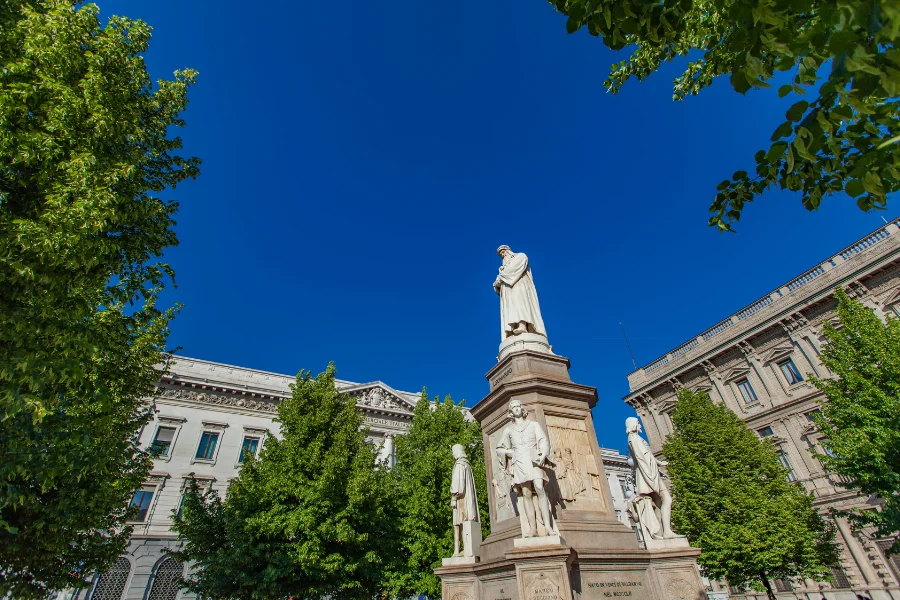
Leonardo da Vinci, born on April 15, 1452, in Vinci, Tuscany, had a unique upbringing. He was the illegitimate son of Ser Piero da Vinci, a notary, and a local woman, Caterina. Raised primarily by his father, he grew up in an intellectually stimulating environment.
Leonardo never married or had children, so he has no direct descendants. His social circle included fellow artists such as Michelangelo and Raphael Santi, although his relationships with them were often competitive.
A lack of records of romantic relationships has led to many myths and speculations. Despite this, Leonardo was known for his deep friendships with his students and companions.
Leonardo is often celebrated for his artworks, such as the Mona Lisa and The Last Supper. These paintings reflect his understanding and appreciation of the human form, possibly influenced by his relations and observations.
Leonardo da Vinci’s journals contain numerous ideas and sketches, offering a glimpse into his thoughts and philosophies. His words articulate his passion for life and art, contributing to countless famous quotes. These writings further demonstrate his complex and introspective nature, shaped by his personal life and interactions with others.
Style and Techniques
Leonardo da Vinci’s artistic brilliance is showcased in his use of chiaroscuro and sfumato, careful perspective, and detailed anatomical accuracy. These methods solidified his place in art history and influenced countless artists, including Michelangelo.
Chiaroscuro and Sfumato
Leonardo’s paintings famously employ chiaroscuro, a technique that utilizes strong contrasts between light and dark. This method brings dramatic depth and three-dimensionality to his works, such as The Last Supper by Leonardo da Vinci.
Another hallmark of Leonardo da Vinci’s work is sfumato, which creates soft transitions between colors and tones. This technique adds a mysterious, smoky quality to the painting by Leonardo da Vinci, “Mona Lisa.” These innovations mark Leonardo’s mastery and creativity.
Perspective Use
Leonardo demonstrated remarkable skill in using perspective to create depth in his art. He applied linear perspective in works like The Last Supper, where architectural elements guide the viewer’s eye to Christ at the center.
This compositional control enhances realism and viewer engagement. The depth of the perspective underscores its emotional impact, drawing the viewer into the scene.
Anatomical Accuracy
Leonardo’s attention to anatomical accuracy set him apart from his contemporaries. His detailed studies of the human body, depicted in works like the Vitruvian Man, demonstrate his scientific approach and how he integrated it into art.
Leonardo’s sketches often depicted muscles, bones, and vascular systems, providing unparalleled insight into human anatomy. His dedication to understanding the human form is a key component of his lasting legacy.
Impact and Legacy
Leonardo da Vinci left an indelible mark on art, science, and popular culture. His visionary ideas and masterpieces have inspired countless others, and his works continue to be celebrated for their technical brilliance and depth.
Influence on Art
Leonardo da Vinci’s influence on art remains profound. His works, such as the iconic Mona Lisa, exhibit unmatched skill in capturing human emotion and intricate detail. The Last Supper brought innovation through perspective and composition, challenging artists and their audiences.
Leonardo developed techniques like sfumato, which creates soft transitions between colors and tones, lending his artworks a lifelike effect. Michelangelo and Raphael Santi were deeply affected by his style, further cementing his impact on the Renaissance and beyond.
Contributions to Science and Technology
Leonardo da Vinci’s interest in science and technology was as significant as his artistic endeavors. His notebooks reveal explorations into anatomy, physics, and engineering concepts that were ahead of their time.
Sketches of flying machines, mechanical innovations, and studies of human anatomy showcased his keen insight and curiosity. He is often credited with ideas that predate modern inventions, such as the helicopter and armored vehicle. His blending of art and science laid the foundation for future generations, emphasizing observation and experimentation as pathways to innovation.
Cultural Icon Status
Beyond his tangible contributions, Leonardo da Vinci has become a cultural icon. His life and works fascinate and inspire many, as evident in numerous books, movies, and exhibitions about his life.
His multifaceted genius has made him a symbol of the Renaissance spirit and a major figure in popular media. Through his masterpieces and ideas, Leonardo remains an enduring subject of study and admiration, challenging us to explore the limits of creativity and intellect.
Major Works Analysis
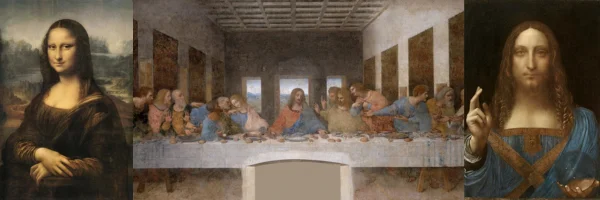
Leonardo da Vinci’s legacy is captured through his unparalleled contributions to art and design. His painting techniques and conceptual designs reflect his mastery and ingenuity.
Iconic Paintings
Leonardo da Vinci is celebrated for many remarkable paintings, the most famous of which is the Mona Lisa. Painted between 1503 and 1519, this portrait is admired for its enigmatic smile and sophisticated use of sfumato, which creates soft transitions between colors.
Another masterpiece, The Last Supper, completed in 1498, showcases his exceptional use of perspective. It depicts the profound moment when Jesus announces that one of his disciples will betray him. These works remain pivotal in the study of art history and are viewed as treasures of the Renaissance era.
Sculptural and Architectural Designs
While Leonardo is best known for his paintings, his designs in sculpture and architecture are equally impressive. He conceptualized many innovative structures and machines, although few were realized in his time. His sketches reveal plans for various inventions, including the flying machine and an armored vehicle.
Leonardo’s architectural designs showcase his profound interest in harmonious proportions and geometric forms. Although less well-known than his paintings, his architectural ideas underscore his artistic vision and scientific approach. His work has inspired future designs and remains influential in understanding Renaissance creativity.
Historical Context
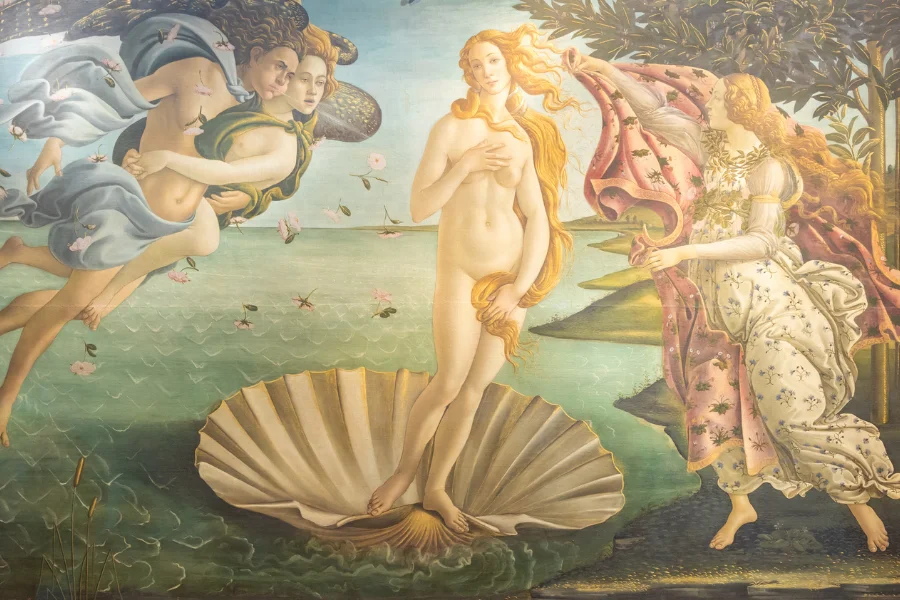
Significant cultural and political changes shaped Leonardo da Vinci’s life and work during the Italian Renaissance. Art and science flourished, and figures like Michelangelo and Raphael shaped the artistic landscape. The political situation in Italy significantly impacted da Vinci’s opportunities and challenges.
Italian Renaissance
The Italian Renaissance marked a period of revival in art and science. This movement began in Italy in the late 14th century and spread throughout Europe, characterized by a renewed interest in classical antiquity and humanism.
In this era, education and learning took center stage. Artists such as Leonardo da Vinci and Michelangelo became renowned for their innovative techniques and meticulous attention to human anatomy.
Leonardo da Vinci’s paintings, such as the Mona Lisa, epitomize the blend of art and science, showcasing a detailed understanding and mastery. His techniques have influenced generations of artists.
The cultural richness of cities like Florence, where da Vinci received training under Andrea del Verrocchio, provided fertile ground for his talents.
Political Dynamics of the Era
Italy was not a unified country but a collection of city-states, each with its own government. Powerful families, such as the Medici in Florence, influenced local politics, art, and culture. The rivalry among these city-states led to shifting alliances and conflicts.
Leonardo navigated this complex political scene. He served the Duke of Milan, Ludovico Sforza, where he created masterpieces like The Last Supper. Such political ties granted him commissions but posed challenges amidst wars and power struggles.
Understanding the political dynamics was crucial for Leonardo as he moved between Florence, Milan, and other cities, seeking patronage and artistic freedom.
Preservation of Leonardo’s Works
Efforts to preserve Leonardo da Vinci’s masterpieces have faced challenges due to the passage of time and past restoration practices. These efforts continue to protect his invaluable artworks for future generations, highlighting successes and inevitable losses.
Restoration Efforts
Extensive restoration efforts have been undertaken to conserve Leonardo da Vinci’s paintings, particularly “The Last Supper.” In 1977, a significant project in Milan employed advanced techniques, including microscopic photography and infrared reflectography, to remove layers of paint added over the centuries.
This process lasted over 38,000 hours and preserved approximately 42.5% of Leonardo da Vinci’s original work. Such endeavors ensure the longevity of iconic pieces, such as the Mona Lisa, housed in the Louvre, which has unique climate controls to prevent deterioration.
Despite challenges, these restorations aim to maintain the integrity and legacy of Leonardo da Vinci’s artworks.
Lost and Surviving Pieces
Many of Leonardo’s original works have been lost, while some remain intact. Art pieces like the “Salvator Mundi,” rediscovered in recent years, demonstrate the ongoing impact of his creations.
While some paintings, such as “The Battle of Anghiari,” exist only in copies or descriptions, others have survived thanks to early collections and restorations. The Vatican Pinacoteca holds “St. Jerome in the Wilderness,” showcasing his unfinished genius.
These pieces attest to Leonardo’s influence across centuries, even as restoration and conservation efforts strive to protect what remains.
Criticism and Interpretations
Leonardo da Vinci’s works have long sparked debate and discussion. Scholars are often divided over his techniques and innovations, while modern audiences consider his masterpieces, such as The Last Supper and Mona Lisa, timeless.
Scholarly Debate
Scholars continuously analyze Leonardo da Vinci’s paintings, noting his pioneering use of techniques such as sfumato. His ability to integrate art with science made his work complex and multi-layered.
Some scholars debate the intentions behind his unfinished paintings, considering them either a testament to his evolving ideas or a result of his perfectionism. Debate also exists concerning his original notebooks, which reveal insights into his theoretical musings on anatomy and geometry.
These texts raise questions about Leonardo’s approach to art versus scientific inquiry. Scholars like Carlo Pedretti have explored these aspects, offering varied interpretations of his techniques and theories.
Modern Reception
Leonardo’s artworks continue to captivate the modern world. His painting, “Salvator Mundi,” fetched record sums at auctions, underscoring his enduring appeal. Public fascination with Leonardo is not limited to art enthusiasts; it extends to a global audience intrigued by his genius.
The “Mona Lisa” draws millions to the Louvre annually, underscoring its impact on popular culture. Documentaries and books, such as Walter Isaacson’s biography of Leonardo da Vinci, highlight his relevance today. Through these mediums, viewers appreciate his blend of creativity and intellect, keeping his legacy alive in popular discourse.
Final Thoughts
Leonardo da Vinci’s legacy is far-reaching and continues to inspire various fields. Known for masterpieces such as the Mona Lisa and The Last Supper, he left an indelible mark on the art world. His ability to merge art with science sets him apart as a true polymath.
In addition to his artistic achievements, Leonardo’s engineering concepts demonstrate his visionary thinking. He is credited with early designs and inventions such as the tank and flying machines. His sketches and notes revealed the depth of his inquisitive mind.
Leonardo’s notebooks encompass a wide range of topics, from anatomy to hydrodynamics. They reflect his constant quest for knowledge and curiosity about the natural world. These manuscripts remain valuable resources for researchers and scholars.
Key Takeaways:
- Leonardo da Vinci’s contributions spanned both art and science.
- His works reveal a blend of creativity and analytical thinking.
His influence remains evident in many disciplines today, underscoring his role as a luminary of the Renaissance era.
Frequently Asked Questions
Leonardo da Vinci is renowned for his remarkable contributions to art and science. His life is filled with fascinating details, from his early years to his famous paintings, such as the Mona Lisa.
Leonardo da Vinci was born on April 15, 1452, in a small village near Vinci, Italy. His birthplace is in Tuscany, a beautiful region known for its rich history and culture.
He remained single throughout his life, and it’s uncertain whether he engaged in any sexually intimate relationships with anyone, regardless of gender. However, art historian Raymond Stites proposed that Leonardo may have had a romantic connection with Cecilia Gallerani, the woman featured in his painting “Lady with an Ermine.”
Leonardo was the son of Ser Piero, a notary, and Caterina, a woman. He grew up with his father and extended family, including several half-siblings.
He spent his early years in Vinci before moving to Florence at the age of 14. Later, he worked in various cities, including Milan and Rome, before moving to France, where he spent his last years.
Leonardo was renowned for his exceptional skills in painting, engineering, and science. His most notable artworks include the Mona Lisa and The Last Supper, which continue to captivate audiences worldwide.
Leonardo da Vinci was an Italian polymath specializing in art, science, engineering, and anatomy. He is celebrated as one of the greatest artists and a pioneering mind of the Renaissance.
Leonardo received some rudimentary schooling and developed an early interest in drawing. He was known for his curiosity and talent in art, which led him to an apprenticeship in Florence.
Leonardo da Vinci died in Amboise, France, on May 2, 1519. He died of a probable stroke at the age of 67, leaving behind an extraordinary legacy.
The identity of the woman depicted in the Mona Lisa is believed to be Lisa Gherardini, who was buried in Florence. Her remains are thought to rest at the convent of St. Ursula.
The Mona Lisa, housed in the Louvre Museum, is considered priceless due to its cultural and historical significance. It remains one of the most valuable artworks in the world.
At age 14, Leonardo moved to Florence to begin an apprenticeship with the artist Andrea del Verrocchio. This experience was crucial in shaping his skills and future career as an artist.
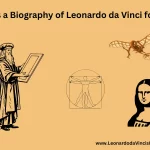


 Leonardo Bianchi,
the creator of Leonardo da Vinci's Inventions.
Thank you for visiting
Leonardo Bianchi,
the creator of Leonardo da Vinci's Inventions.
Thank you for visiting